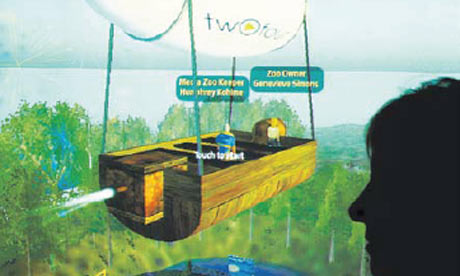Ao longo da matéria o autor traz alguns exeplos de espaços no Second Life utilizados por alguns professores, como o Leicester's Media Zoo. Eu ainda não conheço, mas vou explorar este espaço e em breve trago novos comentários.
Vale a pena também ver o comentário que meu orientador faz em seu blog, comentando alguns aspectos gerais do caderno Estudante Digital.
Abaixo transcrevo na íntegra uma das três partes do caderno:
Is there a Second Life for teaching?
Blank electronic canvas or pointless digital exercise - are virtual online environments the next big thing in education?

Professor Gilly Salmon with her Media Zoo avatar Genevieve Simons in Second Life
The immersive, three-dimensional environment of Second Life is often seen as the latest frontier of education's ever-tightening embrace of new technology. The internet-based virtual world, which allows its users to interact using avatars that float around a vast electronic landscape, has been heavily colonised by higher education institutions since its genesis a little over five years ago. But how useful to educators is it?
Very, argues Gilly Salmon, head of the Beyond Distance Research Alliance at the University of Leicester, and a Second Life evangelist. "It's natural in society that if you put a professor in front of a group of students you will always get a degree of reticence, whereas if the professor is an avatar, it is simply not the same," she says.
Salmon pioneered Leicester's Media Zoo, a cutting-edge research lab that was first established in the physical space of the university to help academics experiment with new technology, and staked out a space in Second Life about 18 months ago. The Media Zoo's Second Life island provides a space in which students, researchers and teachers can experiment with learning in a virtual world.
Salmon believes that Second Life constitutes a good example of "edutainment" - the idea that students are more likely to learn if they are first amused. An example of how this works in practice is the programme developed for archaeology students at Leicester. While learning about the ancient culture of the Sami, the indigenous people that live in the area we call Lapland, the students used Second Life to meet in a virtual representation of one of the tents that the ancient nomads would have used for worship.
"Instead of the students looking at a diagram in the classroom discussing what it would have been like, they were able to go into the tent and experience it and take part as if they were members of the society," says Salmon.
While students reacted positively to the experience, getting them into the virtual world can prove difficult, she says. A recent Jisc/Mori report indicated that Second Life remained the least popular technological pursuit among students.
As many as 76% have never, or only rarely, stepped inside a virtual world, and some students polled thought that environments such as Second Life were "sad".
"I think the average person in Second Life is white, middle-class and over 35," admits Lawrie Phipps, manager of the Users and Innovation Programme at the Jisc. "It's not the easiest and most intuitive tool to use, and because it's not a game - it's just an environment - some people initially go in and wonder why they are there."
Nevertheless, Phipps says that perseverance can reap rewards. "If you are an art and design student, then you have a canvass without boundaries," he says. "Philosophy students can act out roles, and researchers have a safe environment to observe people. The nice thing about Second Life is that the tangible benefits are whatever you need them to be."



Nenhum comentário:
Postar um comentário